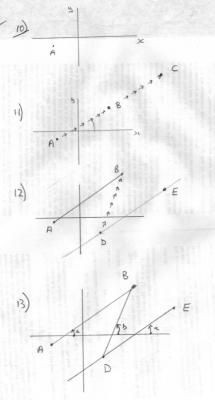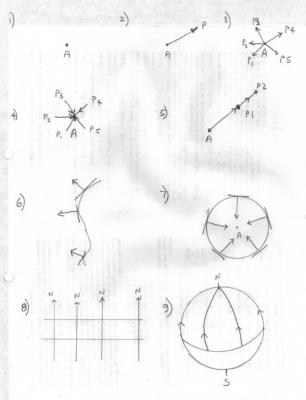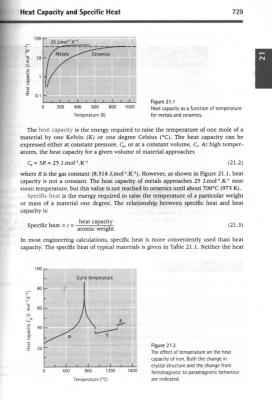-
Posts
18423 -
Joined
-
Last visited
-
Days Won
107
Content Type
Profiles
Forums
Events
Everything posted by studiot
-
Yes I misspelled people. My apologies. Actually my post said nothing about your spelling. This is to do with the fact that you don't break up your text into manageable chunks. Doing that makes it easier for everyone.
-
Waves are repetitive physical phenomena that have a definite time interval between the repetition. The time interval is called the period of the wave. Trigonometric functions are also repetitive mathematical functions with a definite period between repetitions. So it is not suprising that we often use combinations of trigonometric functions to represent waves mathematically. We do not generate physical waves by running something through a trigonometric sausage maker. So are you looking for actual examples of the use of the more complicated trigonometric formulae or are you looking to understand the generation of EM waves by electron acceleration?
-

Quantifying the Physical Property of Direction.
studiot replied to steveupson's topic in Speculations
Change the extension to .txt or something that will lodge here or put it into a zip file. Provide instructions to others to change it back before use. -

Quantifying the Physical Property of Direction.
studiot replied to steveupson's topic in Speculations
Steve, I think this call is time to refer to previous discussions on direction. You will also note that this starts off by suggesting what many have already said, notably you need two points to establish (a reference) direction. Please note also that you originally presented the following as your proposed 'function' but could not tell me if the angle units were radians or degrees, although you only talk of degrees. Are you now ready to answer that question? -
The microphone in the studio converts the sound wave to an electrical wave. This electrical wave copy of the sound wave is superimposed on a radio carrier wave and received at the radio receiver. The loudspeaker in the receiver is a form of electric motor that moves backwards and forwards (rather than going round and round) when driven by an electric current. The backwards and forwards motion pushes the air to create a sound. So if the speaker is driven by an electrical copy of the original sound wave it pushes the air in the receiving room to create an audible copy in the air. Like any motor the greater the drive current the stronger the motion and in this case the louder the sound. So the reciever contains electrical amplification circuitry to make the driving electrical signal larger or smaller. That is make the whole of the electrical copy large (or smaller) in the same proportion. This is controlled by the volume control.
-

Quantifying the Physical Property of Direction.
studiot replied to steveupson's topic in Speculations
These are called skew lines. I won't offer you any more textbooks, these days on the internet there are many offerings on the subject. Take your pick. https://www.google.co.uk/search?hl=en-GB&source=hp&biw=&bih=&q=angle+between+skew+lines&gbv=2&oq=angle+between+skew+lines&gs_l=heirloom-hp.1.0.0j0i22i30l3.922.6734.0.11750.24.19.0.5.5.0.203.2235.2j12j2.16.0....0...1ac.1.34.heirloom-hp..3.21.2420.bsVJXvT_MRc I'm glad to see you are now trying to use the same terminology as every one else. That will help your case no end. As regards the circulation of a vector field, the maths is hard, but the explanation is easier. If you consider any vector field and draw a closed loop in its space and take a unit (or other) vector for a walk around the loop then you can calculate an important property of that field called the circulation. By take a vector for a walk I mean start somewhere on the loop (say point A) and align your moving (walking) vector with the vector field at each point of the loop until you come back to A (complete the loop). As you move around the loop the walking vector will turn to point this way and that. When you return to A it will be pointing in the same direction as when you started. Now at each point of the loop there is another vector, the tangent vector of the loop. Now form the dot product of these two vectors. Now integrate (add up) all these dot products around the loop. The thing is that for some vector fields, like gravity, this will be zero. But for other vectors fields, like the velocity field of moving air, it may result in a calculable non zero number. In Physics it is this circulation which is responsible for generating the lift force to allow aircraft to fly. In symbols we have [math]C = \oint {V \bullet dl} [/math] Where C is the scalar circulation V is the field vector and dl is the differential length vector along the curve. -

Quantifying the Physical Property of Direction.
studiot replied to steveupson's topic in Speculations
It should be noted that it is perfectly possible to separate the direction and magnitude attributes of vectors. The zero vector has no direction (or indeterminate if you prefer) Any vector in a direction field has no magnitude (or indeterminate magnitude if you prefer) -
I have seen your name on the forums, but rarely in the threads that I participate in so I have little or no experience of your questions. I sympathise with your desire to learn and to receive answers appropriate to your level of understanding. But please understand that it can be quite dispiriting to see someone asking what are basically the wrong questions, because they don't know enough to ask the right ones. If they then listen to a development of the subject, sufficient to show them the way and even provide some sort of answer to their original question then it is great. Note also that such a development may need to be spread over several posts and can involve substantial effort on the explainer's part. But some (and I'm not saying you do this) refuse to work through to get to their goal, usually unpsetting all parties in the process. As regards to your English language style. Imagine your lecturer at college (including art college) putting up a powerpoint phrased as your post#41. Yes it is readable Yes I understood it But a lot of stuff presented like that, peple turn off because they think "If the questioner can't be bothered to present their case smartly, then they are showing they don't care. So why should I?" This is very much like the standard advice in going for a job interview. If the applicant shows they don't care, how will they act in work?
-

Quantifying the Physical Property of Direction.
studiot replied to steveupson's topic in Speculations
The notion of direction has many interesting properties of its own. Walk steadily away from the North Pole (ie place your back to it) and keep going. Where will you end up? -
So are you suggesting that a well qualified scientist with 25 or 30 years experience under his/her belt should not consider the tenderness of a fifteen year old?
-
Regardless of how complex you make your answer, there is another consideration IMHO. There are a wide range of posters of incorrect material starting threads. By this I mean that some are obsessive about particular incorrect view or proposition they hold too, regardless of atempts to point them in the right direction. Little can be done for these. But there are those who have an incorrect idea, but are prepared to be shown why they do not have enough knowledge to see that their proposition is inappropriate, although on the face of it their idea seems good. We should nurture this latter group, not jump hard on them, particularly if they are still school pupils. I remember when I was in secondary school I had this idea, after studying very elementary architectural and builders' structural mechanics, that I would like to apply 'structural mechanics' to molecular architecture, using the same principles, as nobody seemed to be doing this. In those days we did not have the internet and I was left to work out for myself why my idea was inappropriate at a much later date, when I had aquired the necessary wider knowledge. But how many here have had apparantly viable ideas like this in their younger days, only to have it brutally squashed by someone further along the path?
-
Like the linked diagram, thanks. +1 This is a good reason to visit SF, to be told about good work that others have done and we did not know about before.
-

Quantifying the Physical Property of Direction.
studiot replied to steveupson's topic in Speculations
Not at all I was quite serious. -
Since you know it all, but are unwilling to enlighten us, I can only say that I am sorry you cannot make it 'work', whatever you mean by that. I can only repeat my first response. The mesh method is a very general method that always allows analysis. So you must have applied it incorrectly. But since you won't tell us what you have done, I can't comment.
-

Quantifying the Physical Property of Direction.
studiot replied to steveupson's topic in Speculations
Hello Steve, I think we have been through 50 shades of the true meaning of the words direction, function and property on a dedicated maths site and established you do not refer to the conventional definition of either. I have had a new thought that there is a property that might interest you. Unfortunately it requires vector calculus to perform any calculations with it, but it is understandable in plain English without that. It is called the circulation of a vector field and has the attractive property, from your point of view, of being a scalar that has some relation to the notion of direction. Perhaps Mordred will explain it? -
So was that a reply to my request for your calculations? We do not do your homework for you, but it is clear you have not understood mesh analysis so If you are still interested I will post one of my rough guides to help you. This will include a couple of simple worked examples. Over to you.
-
Because you have done something incorrect? But I see no working to comment on. Of course, the question arises, which mesh current law are you trying to use? There are several versions. Most problems arise when folks try to mix'n'match methods, which you can't do.
-
Sanity returns to this thread. +1
-
There are several ways to analyse a catenary So what subject are you studying this in and at what level? There is no hint in your profile other than that your favourite subject is physics. Looking at the picture you posted a snapshot of I don't think it came from a calculus of variations text book. This is quite an advanced way to approaching the problem. Note the calculus of variations is a more advanced technique, not normally taught until well after other forms of calculus have been studied. The standard solution requires only more elementary calculus. Why do you say you are required calculus to solve this? How do you know the curve is a catenary, since the question does not state this and what do you know about this curve? How do you know that RN1 = 3000 since the question does not state that either? If this is a physics problem as it appears have you tried applying the standard conditions of equilibrium to the cable or part of it as a free body?
-
Note I was talking about siblings supporting each other not the patient. I assumed your question about telling the children concerned the effect on them not the patient. I also assumed that patient as a parent was concerned with the effect on the children.
-
This is one of those situations that one may theorise about, but act totally differently if one ever gets into that situation. Not having personal experience of this I would offer the following. I would think that a number of children is better than a single child of what ever age, as they would be able to support one and other through whatever is to come in the future, rather than put it all on one child. So treat them as a group, at least with the generalities. Add specifics for the older ones as far as they can handle.
-
Here is another view of 'curvature'. First consider the usual x,y,z axes for space and then t for time. We expect the numbers along the space (and time) axes to be distributed evenly and regularly. That is we expect them to be linearly distributed. and indeed they are in special relativity, which introduces spacetime. Spacetime is 'flat' which is another way of saying the numbers are distributed evenly and regularly or in a linear fashion. So is ordinary 'space'. Now introduce another entity that has some non linear effect across the axes already defined (ie space, and time) For instance mass. We know one representation of this effect is a force which varies non linearly with the square of the distance. Another interpretation is that the mathematical system of space plus mass exhibits 'curvature', because of the mass. It does not mean there is a further axis in which space 'bends'. The curvature is the nonlinearity coming out when we create mathematical objects (systems) that combine the space and the additional effect eg mass. This is exactly what Mordred posted earlier The non-linearity introduced by adding the density (rho) term to the mathematical system (called a tensor) is reflected in (or develops) a non linearity in the rest of the system, that was linear without it. A tensor is simply a way to collect all (or at least as many as desirable) of the properties of interest into one basket as possible.
-
Are you sure you mean that and not something quite different? Things are, after all, nouns and do not require causes. I'm not convinced that quantum mechanics requires causes either. It often offers predictions in the form of probabilities. But it does not preclude other forms of analysis that offer different ways of presenting results.
-

Theory of Human Response to the Effects of Tectonic Stress
studiot replied to Alan Watson's topic in Other Sciences
It's a question of understanding, not doubt. So if I understand you correctly you are taking instance of a quake in England & Wales, without further subdivision, and any occurrence of a riot in the same total area. The UK has a substantially diagonally banded geological structure, running SW to NE. So (and I don't know if the were any), a quake in Deal would be linked to a riot in Barrow-in furness if they fell with your selected time frame. Such a link would cut directly across all those diagonals. I don't know if the other diagonal would be more productive. That is a quake in Penzance linking to another Jarrow riot. -

Specific heat of cast iron at very high temperatures
studiot replied to Soderdahl's topic in Engineering




